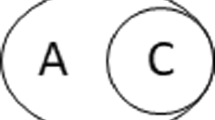Conclusion
It is true, then, that a generalized statement of Arnauldic essentialism is equivalent to a qmlwff. But no known objection to quantified modal logic rightly or even reasonably dispatches any qmlwff to which essentialism commits us. This is scarcely a surprising state of affairs. For, the heart (I shall not say ‘essence’) of these complaints against quantified modal logic is that quantified modal logic cannot be given a coherent interpretation that preserves the distinction between
Now when a logician charges that a system of logic cannot coherently be given its intended interpretation, and another logician demonstrably provides for that system a formal semantics that is complete and consistent and consonant with the underlying intuitions of the system, then it is universally concluded that the original objection has altogether satisfactorily been disposed of. Kripke and others have furnished, for systems of quantified modal logic, such complete and consistent semantics. Yet skepticism concerning quantified modal logic continues in some quarters vigorously to be pressed. The question is: what really is the basis of such skepticism?, for it is not, as all the world should know, that quantified modal logic cannot be interpreted. Whatever the answer may be, we should at least be prepared to consider the possibility that some of the apparent trouble for quantified modal logic proceeds from unintended and undetected breaches of such principles as semantic constancy.
Similar content being viewed by others
Bibliography
JohnWoods, ‘Essentialism, Self-Identity and Quantifying In’, in: Identity and Individuation (ed. by Milton K.Munitz), New York, New York University Press, 1971.
P. F.Strawson, ‘On Referring’, in Philosophy and Ordinary Language (ed. by Charles E.Caton), Urbana, University of Illinois Press, 1963.
W. V.Quine, From a Logical Point of View, Cambridge, Harvard University Press, 1953.
W. V.Quine, ‘Notes on Existence and Necessity’, J. Philosophy 40 (1943), 113–127.
W. V.Quine, ‘The Problem of Interpreting Modal Logic’, J. Symbolic Logic 12 (1947), 43–48.
W. V.Quine, The Ways of Paradox, New York, Random House, 1966.
John Woods, Identity and Modality, Mimeographed, University of Victoria, October 1971.
W. V.Quine, Word and Object, New York, John Wiley, 1960.
Saul Kripke, ‘Identity and Necessity’, in Munitz, Identity and Individuation.
Author information
Authors and Affiliations
Rights and permissions
About this article
Cite this article
Woods, J. Descriptions, essences and quantified modal logic. J Philos Logic 2, 304–321 (1973). https://doi.org/10.1007/BF00263361
Issue Date:
DOI: https://doi.org/10.1007/BF00263361




